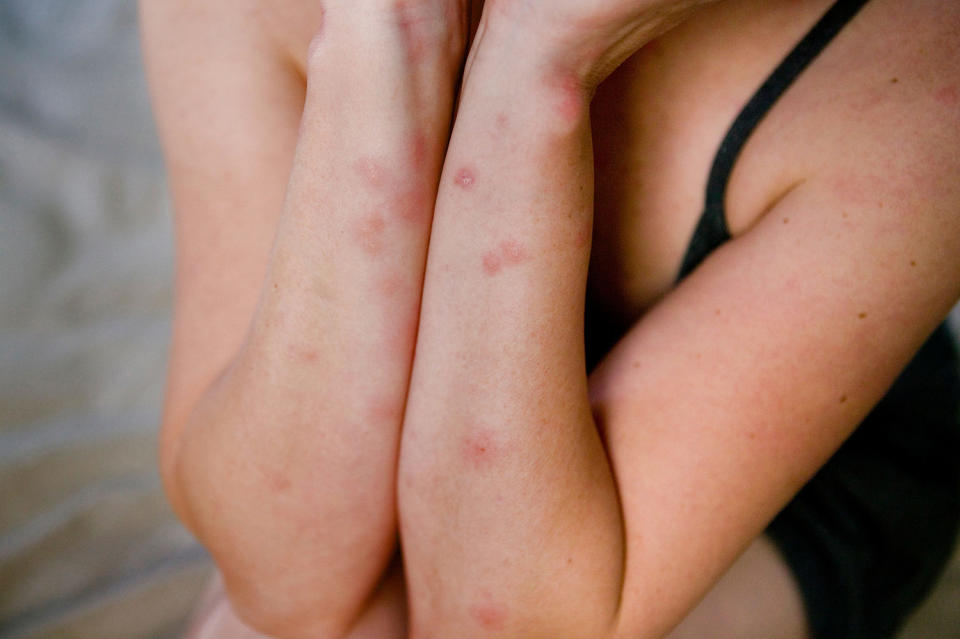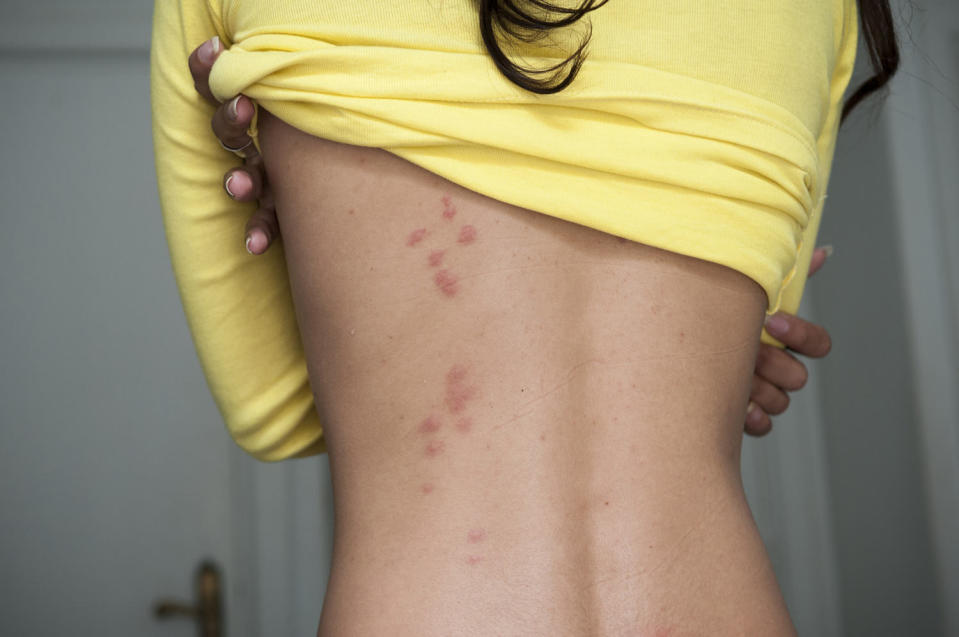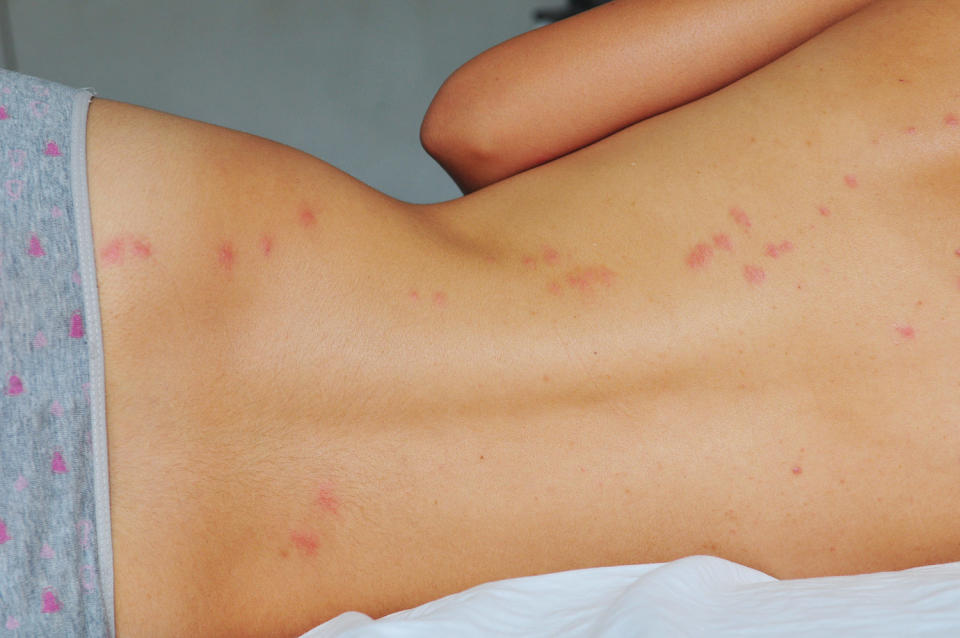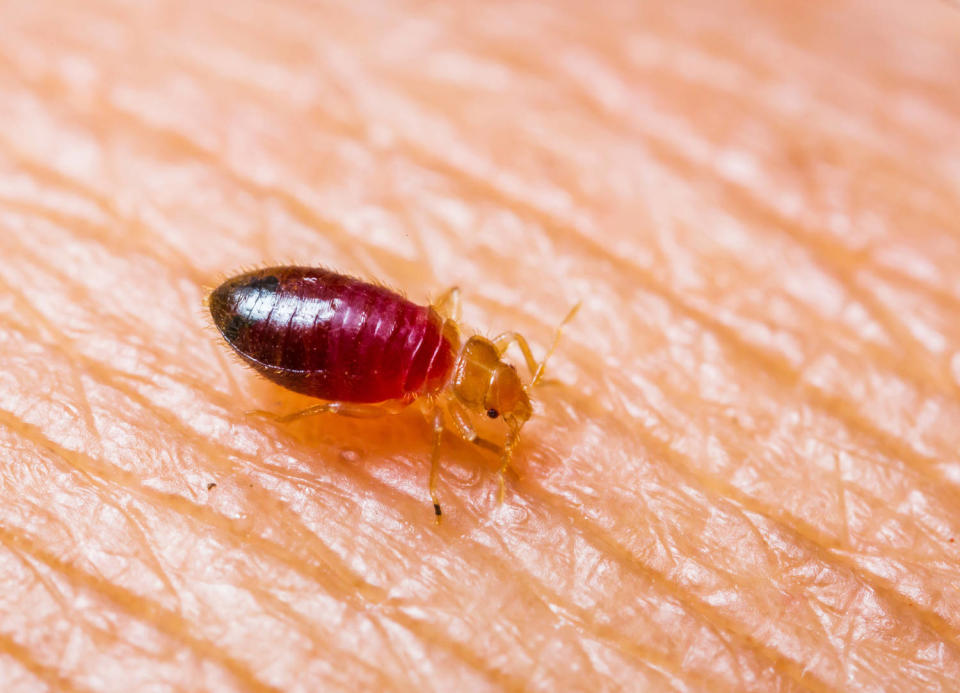What do bedbug bites look like? Pictures to help you identify and treat them

- Oops!Something went wrong.Please try again later.
Bedbugs aren't always easy to spot in your home. But bedbug bites are usually hard to miss. The red, raised, itchy welts may even be the only obvious sign you have bedbugs, experts say, so it's a good idea to know what bedbug bites look like.
The truth is that bedbugs are pretty much everywhere — from New York City apartments to Paris Fashion Week. They live across the globe, the Centers for Disease Control and Prevention say, and they’ve been found in parts of North and South America, Europe, Asia and Africa.
Recently, videos of bedbugs crawling around the Paris Metro were published on social media along with reports of people seeing the critters in movie theaters and at Charles de Gaulle Airport. With the Paris Olympics set to kick off this summer, it's no surprise that both tourists and residents are on high alert.
Staying at a fancy, five-star hotel isn't a guarantee that you'll avoid them. But knowing what bedbug bites look like can help you get it taken care of as quickly as possible. If you suspect you have bedbugs, here's what experts recommend looking out for and pictures of bedbug bites to help you identify the marks.
How to know if you have bedbugs:
As widespread and annoying as bedbugs are, the reclusive creatures are surprisingly hard to spot.
“Bedbugs are kind of a cryptic species," Matt Frye, Ph.D., an entomologist and educator with the New York State Integrated Pest Management Program at Cornell University, tells TODAY.com.
Bedbugs generally "like to hide and they don’t want to be detected,” he explains. They prefer to live in places that are cramped, dark and near food (you).
"You can assume that they're going to be somewhere near where you spend a lot of time in the dark," Lynn Kimsey, Ph.D., distinguished professor of entomology and director of the UC Davis Bohart Museum of Entomology, tells TODAY.com.
You might find bedbugs in an area of your home where you spend a lot of time while staying relatively still, such as your bed, couch or favorite comfy chair, she says.
Bedbugs sometimes leave behind rust-colored stains on fabric, or you may find the exoskeletons they've shed. But, often, the only recognizable sign that you’re dealing with a bedbug infestation is the itchy, red clusters of bites they can leave you with (as you can see in the below pictures of bedbug bites).
The catch is that not everyone develops those noticeable skin reactions after a bedbug bite, the CDC notes. And even if you do have itchy bite marks, it's easy to confuse them with similar bites from other critters, like mosquitoes.
Here's what you need to know about bedbugs, photos to help you identify bedbug bites and warning signs that you might have lots of tiny, hungry new roommates.
What do bedbug bites look like?

Remember that bedbugs are parasitic insects that bite people and eat their blood. That's unsettling enough on its own, but to make matters even worse, the bites can also cause irritating skin reactions.
People can react to bedbugs in so many different ways that it can be challenging — sometimes even impossible — to identify bedbug bites from the bites alone, Frye says. Depending on the person, bedbug bites might look similar to flea bites, mosquito bites or spider bites, or they might not be noticeable at all.
“There’s nothing truly unique about lesions caused by bedbugs” that can be used to diagnose them, dermatologist Dr. Benjamin N. Ungar tells TODAY.com.
While there are some clues to determine if you have bedbug bites, "they're by no means foolproof," says Ungar, who is the director of the Alopecia Center of Excellence and director of the Rosacea and Seborrheic Dermatitis Clinic at Mount Sinai.
The most common way a bedbug bite shows up is a red itchy bump, he explains. There can also be a flat area of redness surrounding the bump itself. For some people, the reaction can be as small as a pinprick, Frye says, while others have "fairly exuberant" reactions, adds Ungar.
Are bedbug bites itchy?
In general, bedbug bites may cause:
Redness
Itchiness
Raised, inflamed skin bumps
At the extreme end of the spectrum, people may have reactions all over their bodies.
“A part of their body that wasn’t touched or bitten by bedbugs can start itching,” Frye says. “They can have whole-body sensations as a result of the proteins that are injected through the saliva.”
In rare cases, people can develop severe allergic reactions to bedbug bites, Ungar says, which can include symptoms such as:
Itching in places that weren't bitten
Trouble breathing
Swelling in the tongue or lips
Symptoms like these indicate a serious, potentially life-threatening reaction that requires immediate medical attention, Ungar says.
Having bedbugs or being concerned that you might have an infestation can also lead to mental distress and symptoms such as insomnia and anxiety, Frye says.

Where do bedbugs bite?
Bedbugs can bite any area of your skin that isn't tightly covered, including your legs, arms and back.
"They tend to be fairly lazy, to be honest," Kimsey says. Usually, that means they bite areas of skin closest to the surface they're walking on, which may be the side of your legs that's closest to the mattress.
Bedbugs also tend to leave bites in clusters or in a line that's sometimes referred to as a "breakfast, lunch and dinner" pattern, Ungar explains. "Again, that's because it's easy," Kimsey says.
When do bedbugs bite?
"They're going to be most likely to feed on you when you're immobile for any length of time," Kimsey says. Most often that's when you're sleeping during the night. But bedbugs can also bite when you're immobile for shorter lengths of time, like while napping or watching TV on the couch.
Depending on their age, bedbugs may feed for anywhere between five to 15 minutes at a time, Frye says. They may spend that whole time in one place or they might move around trying to find the ideal spot on your skin, leaving multiple bites along the way.
“If there are a couple of adult bugs that are all feeding at the same time, you can probably have five to 10 bites that are from those two to three bugs,” he explains.
Where do bedbugs live?
Bedbugs can live in any dark, compact space, Kimsey says, like the folds along the seams or piping of a mattress or sofa.
"They really prefer to be located as close to a food source as possible," Frye says. "And in this case, the food source is going to be people." Bedbugs can also be skittish and easily scared by a food source that moves, so they prefer to strike while people are immobile, like when they're asleep.
That’s why they’re most often found in areas of the bedroom that are close to where people sleep, like the headboard or crevices in the wall or floorboards, Frye says. “They can fit into very tiny cracks that are the thickness of a credit card, and they will actually aggregate in those areas.”
When bedbugs aren't feeding, "they tend to retreat" into those crevices, as well as places like electrical outlets or even inside computers, Kimsey says.

Signs you might have bedbugs
In many cases, people only notice the bites. And it can take a lot of training to pick up on the other signs that you have a bedbug infestation, Kimsey says. "It's so hard to find their resting places," she says.
But, as Frye noted, it can be difficult to identify conclusively that your bites are from bedbugs without other signs of infestation.
Some signs you might notice include:
Black or rust-colored "fecal stains" might appear on bedding or near where the bugs are holding up, Frye says. These are the result of oxidized iron in blood they've eaten and excreted, Kimsey explains.
Keep an eye out for exoskeletons that are left behind when bedbugs shed, Frye says. "That can cling to fabric and other material near where they are molting," he explains.
A faint tangy smell, which is more noticeable with severe infestations, Kimsey says.
You might also see live bedbugs, Frye says. They'll typically stay close to where they feed, so you're more likely to spot them in the bedroom than the kitchen or bathroom, Kimsey says.

How to treat bedbug bites
The first thing to do, the experts agree, is to investigate whether or not you truly have bedbugs — which means calling in professional pest control.
There are ways to manage the bites, but "unless the underlying issue of the bedbug presence is addressed, then there's a high likelihood that new lesions will develop," Ungar says.
To manage itchiness and skin irritation, Ungar suggests:
Taking an oral antihistamine. At night, a sedating antihistamine (such as Benadryl) can ease the itching and help you sleep, Ungar says. During the day, try a non-drowsy option, such as Zyrtec, Allegra, Claritin or Xyzal
Using an over-the-counter topical hydrocortisone product
Trying an over-the-counter topical antihistamine
The over-the-counter topical options are worth trying, Ungar says, but tend not to have much of an effect on bedbug bites. A dermatologist can prescribe stronger versions of those medications that are more likely to help, he says.
Checking in with your doctor or dermatologist can also help you determine exactly what type of skin issue you're dealing with.
Bug bites, eczema and even hives "can show up in different ways that are not always easy to spot," Ungar explains. And it's not easy for people who don't have prior experience with them to figure out on their own what their skin is really trying to tell them.
This article was originally published on TODAY.com

